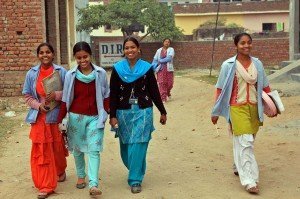Promoting Health

It would take armies of medical professionals and mountains of money to treat the millions of Indians who have health problems. Yet 98% of the most common diseases are preventable. My aim is to demonstrate that it costs almost nothing to promote health in a way that prevents precisely those diseases.
— Dr. Frederick Shaw, Founder and CEO, DIR
Our approach
DIR’s development plan includes nine main steps that support a cycle of CONTINUOUS progress:
progress:
- Train LOCAL
 residents to serve as Health PROMOTERS
residents to serve as Health PROMOTERS (HPs), thus building a network of experts within the community.
(HPs), thus building a network of experts within the community. - SURVEY
 the entire community to establish the baseline for health indicators such as childhood malnutrition, infant mortality rates, immunization rates and birthing practices.
the entire community to establish the baseline for health indicators such as childhood malnutrition, infant mortality rates, immunization rates and birthing practices. - Identify the most urgent problems that are undermining health within the community.
- Educate HPs about the root causes of health problems and teach them to recognize symptoms.
- Through HPs, engage residents in developing solutions, encouraging low-cost, straightforward ACTION
 that values traditional knowledge while ADDRESSING
that values traditional knowledge while ADDRESSING knowledge gaps.
knowledge gaps. - Set clear, measurable targets for the end goal and milestones along the way, thereby ensuring that proposed solutions are effective or can be adapted as necessary.
- Create learning OPPORTUNITIES
 for all community members, using diverse methods to reach different AGES
for all community members, using diverse methods to reach different AGES or cultural groups.
or cultural groups. - Monitor the level of learning achieved, including the adoption of healthier practices in daily life and at the community level.
- Evaluate if whether the original problem has been solved:
- If no, revise strategy to achieve the established goals;
- If yes, identify the next most urgent problem.
Each time DIR works with the community to cycle through this process, the knowledge base for tackling the next problem is strengthened, and individuals gain confidence in their ability to work together to ADDRESS multiple challenges.
multiple challenges.
Six Areas of Greatest Need
During its initial survey of Janta Colony residents, DIR uncovered six areas of great need in the area of health. After prioritizing the degree of urgency, DIR educated HPs about root causes, taught them to recognize symptoms and trained them to intervene by working closely with affected individuals and groups. In each case, targeted action has delivered positive results.
- Severe malnutrition among children under 5 years of age
- High infant mortality rate (IMR)
- Low levels of child immunization
- High rates of adult and child tuberculosis
- High levels of malaria and dengue fever
- Low levels of basic hygiene

